Art Fairs
In Dallas, the Elusive Middle-Market Collector Is Alive and Well. But Are Dealers Willing to Woo Them?
While the Dallas Art Fair's latest edition reached further toward the high end than ever, the depth of the market was in the middle.
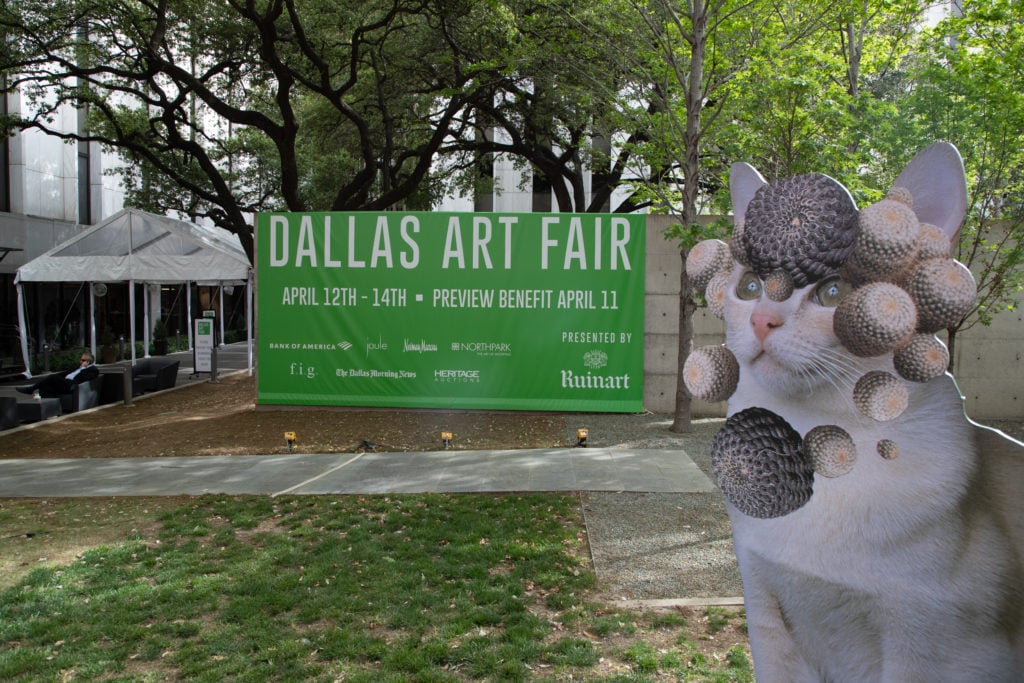
While the Dallas Art Fair's latest edition reached further toward the high end than ever, the depth of the market was in the middle.

by
Tim Schneider

It can be dangerous to read a story of an art fair as a story about its host city. After all, the traditional art market is increasingly an arena for the elite. Yet the Dallas Art Fair acts as a better proxy than most for the region it calls home, and its latest iteration reinforced the reasons that more and more dealers at all levels of the commercial hierarchy find themselves rocketing toward the Lone Star State each spring—or perhaps should.
When the fair’s inaugural edition launched in April 2009, the country and the world had yet to hit rock bottom in the global financial crisis. Just a month earlier, the Dow Jones Industrial Average plummeted under 6,600, cementing the recession as the nation’s worst downturn since the Great Depression. But other dark milestones of the era, such as the bankruptcy of General Motors and the first 10 percent unemployment rate in the US since 1982, were still months away.
That spring, the fair debuted with a few dozen exhibitors. None were galleries based outside the US, and, to hear one of this year’s returning sellers tell it, some were less “galleries” than boutiques hocking jewelry and accessories. Brandon Kennedy, director of exhibitor relations for the fair, called its origins “very fledgling, very homespun.”
But while many, if not most, other state economies needed the succeeding decade just to wobble back into fighting shape, Texas dodged the economic uppercuts and kept charging forward. “There was no recession down here,” Kennedy said.
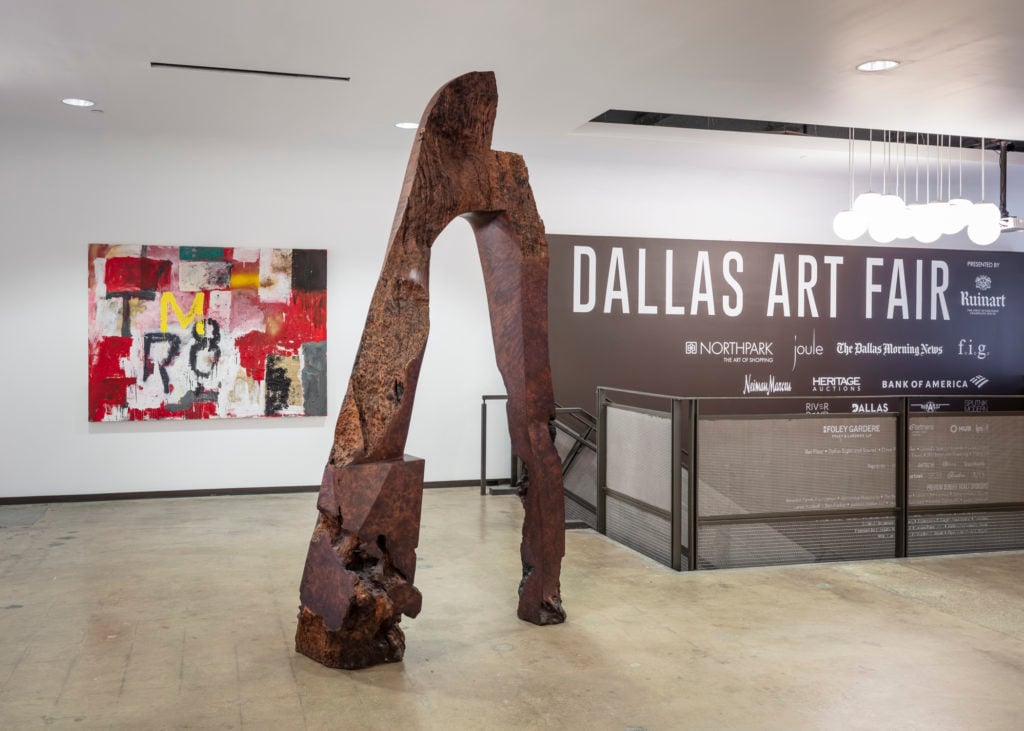
Visitors to the second floor of the 2019 Dallas Art Fair were greeted by J.B. Blunk’s Wishbone, 1977, presented by Los Angeles’s the Landing. Photography by Silvia Ros. Courtesy of the Dallas Art Fair.
Sure, the state continued to gush black gold—Texas is on track to produce more barrels of oil in 2019 than every country except Saudi Arabia and Russia, according to HSBC—but its factories kept building, too. Today, Texas accounts for 10 percent of all American manufactured goods. It also became a hub for the tech industry, employing more than 270,000 such workers and leading the nation in tech exports from 2013 through 2015. If Texas had fulfilled secessionist fantasies of leaving the union, its GDP would have ranked it as the 12th largest economy in the world in 2016. And the state’s refusal to levy either personal or corporate income tax helps explain why AT&T is in the midst of joining Toyota, ExxonMobil, Ericsson, LG, IKEA, and Unilever in calling the Dallas-Fort Worth area its corporate home in the US.
The Dallas Art Fair has grown along with the state’s and city’s fortunes. Completed this Sunday, the eleventh edition of the invitation-only fair hosted 94 exhibitors from locales as far-reaching as Brussels, Dubai, Ukraine, and Japan. The Fashion Industry Gallery, the fair’s longtime venue, has been stretched near its capacity. The dealers making their first sojourn to Big D’s biggest fair included heavyweights like Perrotin, Lisson, and Sadie Coles HQ.
And outside the fair itself, what was known only a handful of years ago as Dallas Arts Week has grown into Dallas Arts Month, a 30-day blowout linking the fair to cultural happenings at venues ranging from collectors’ homes to private foundations to the Dallas Museum of Art and Nasher Sculpture Center. When Kennedy references Dallas’s real-estate boom by saying, “All you see are cranes,” it could just as easily be a metaphor.

Denny Dimin Gallery’s booth at the 2019 Dallas Art Fair, featuring works by Amanda Valdez and Future Retrieval. Courtesy Denny Dimin Gallery.
Still, despite all the success the city and its art scene have experienced in this span, the fair’s exhibitors nevertheless found that there were few gains to be made without hard work and a little patience. The words that dealers most often used to frame their approach to Dallas sounded eerily like those they use to describe their approach to fairs in Hong Kong, Taipei, and other emerging international markets: We’re not expecting sales pyrotechnics in the first few hours. We understand buyers here play a long game, and we’re ready and willing to play it right along with them.
“It’s not a Miami-type situation,” said Robert Dimin, co-founder of New York’s Denny Dimin Gallery, at the fair’s VIP preview on Thursday. Instead of frantically texting dealers at midnight to try to close deals, collectors at the Dallas Art Fair have a reputation for scouting every day of the event to get comfortable with a work or a seller before deciding to acquire. “Today is a social event,” said sales associate Rupert Martin of London gallery State near the end of the preview night. “It makes me feel a bit like the entertainment.”
More often than not, those who were willing to be patient seemed to be rewarded. Lisson placed six works adding up to nearly $300,000 in sales, including Cory Arcangel’s video Jeans / Lakes for $60,000, a Pedro Reyes bronze for $50,000, and three Stanley Whitney gouaches for $18,000 each. But it took the illustrious gallery until Monday to finalize far and away the most lucrative of those transactions: a suite of eight drawings by Reyes for $120,000.
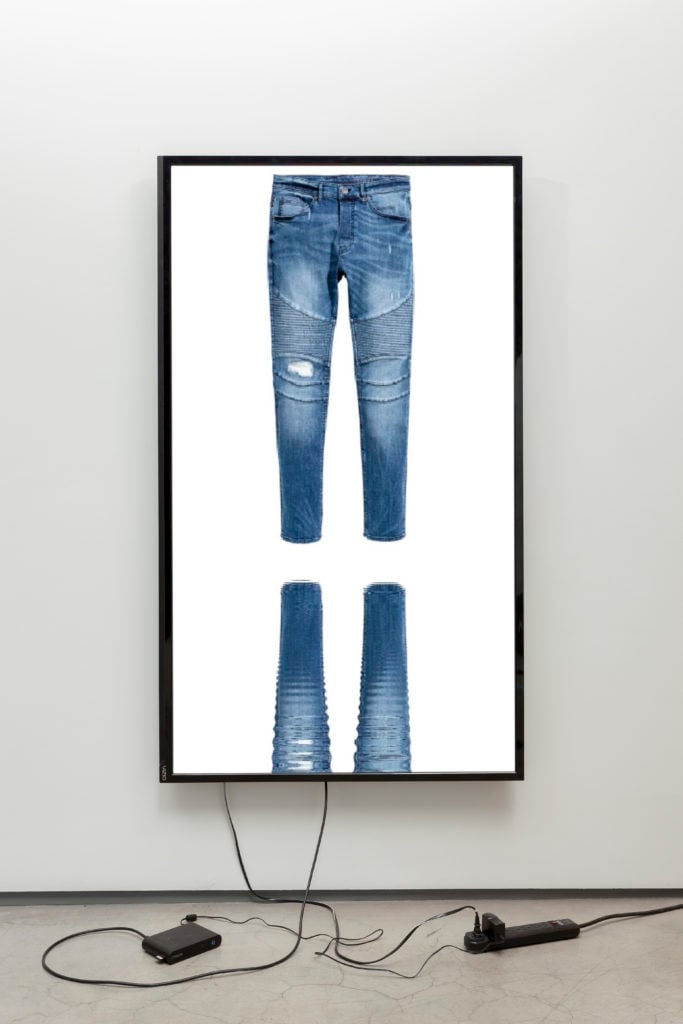
Cory Arcangel, Jeans / Lakes, 2016. © Cory Arcangel. Courtesy Lisson Gallery.
Entertaining turned out to be good business for State, too, as the gallery placed a mirrored Anish Kapoor for $650,000 in the latter stages of the fair.
The slow-and-steady approach also paid dividends at the more modest end of the commercial hierarchy. Although Denny Dimin placed one work by Amanda Valdez on opening night, it ultimately came out of the weekend having sold 13 more by Valdez and Future Retrieval, the artist-duo of Katie Parker and Guy Michael Davis, for between $1,000 and $16,000 each.
Midway through Friday, Kyiv-based Voloshyn Gallery, the fair’s first exhibitor from Ukraine, still had its entire booth available, including works by Zhanna Kadyrova, who will represent the former Soviet republic at the Venice Biennale. As of Sunday afternoon, though, it had sold a large landscape painting on glass by Mikhailo Deyak, and two other pieces were on reserve. Like Dimin, its co-founders expressed a strong desire to return again next year.
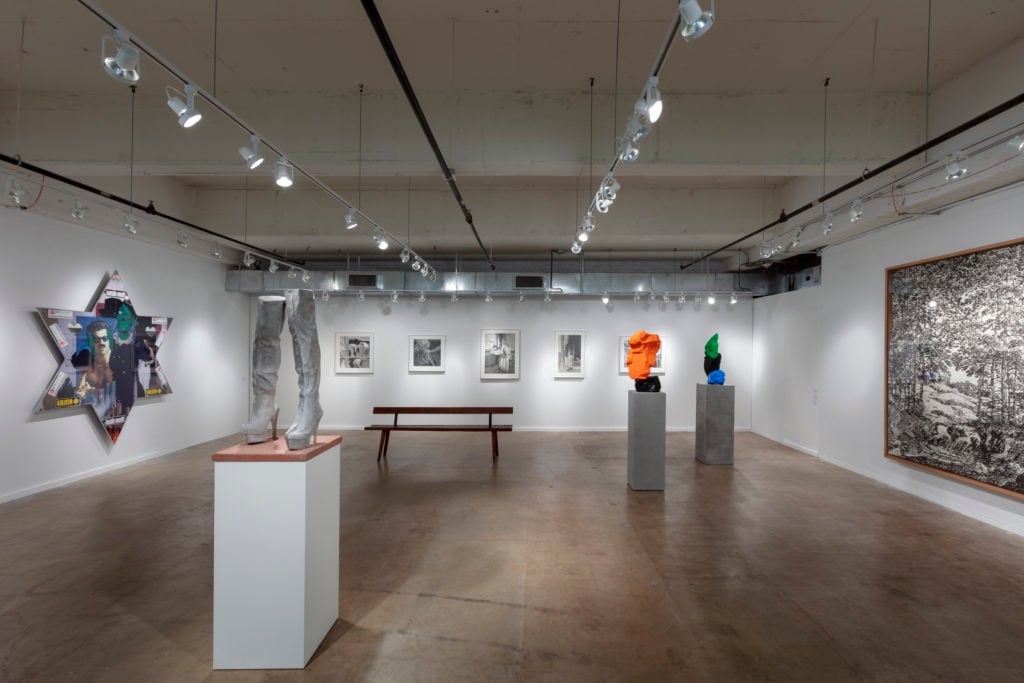
Sadie Coles HQ’s booth at the 2019 Dallas Art Fair, including works by Sarah Lucas, Jordan Wolfson, Ugo Rondinone, and Michele Abelas. © The artists, courtesy Sadie Coles HQ, London. Photography by Kevin Todora.
At the same time as they were slowly closing deals, powerhouse gallerists also gave tacit indicators that they felt the Dallas market still had some growing up to do by international standards. Most blue-chip galleries chose to feature relatively unambitious works, even in an art-fair context, and their namesakes tended to send lieutenants rather than manning the booths themselves, even on opening night. Domestic sizes, bright colors, and abstractions abounded. Touring the galleries exposed the average visitor to more landscapes than a John Ford movie marathon.
It’s up for debate as to how many of these choices were based on lingering regional stereotypes. “I’m from the Midwest. I know what it’s like when people from New York or London won’t give you the time of day,” said director James Shaeffer of Simon Lee on Friday. Returning for the third year, the gallery presented a solo booth of paintings by British artist Clare Woods, who recently completed a permanent installation on the exterior of the Dallas Art Fair’s year-round exhibition space, 214 Projects.
Shaeffer says the gallery sold Woods’s works, priced from £12,000 to £42,000 ($15,670 to $54,840), “consistently” from the VIP night on. But he credits this success to the gallery’s understanding that cultivating relationships in the region requires more than parachuting in for a single weekend equipped with international name recognition. “These people aren’t stupid. You give them respect, they return it,” he said. “I come down here four times a year, and that’s why I think we do well on the [fair’s] opening nights.”
Even a scorching hot artist wasn’t necessarily enough to negate the need to build trust. As of Sunday afternoon, London’s Vigo Gallery had sold one work by emerging abstract painter Johnny Abrahams, but two large-scale mixed-media collages by the highly in-demand Derrick Adams were still available despite having been included in a recent museum exhibition. “I think it will take time to build these relationships, but that is… as it should be,” director Toby Clarke wrote in an email Sunday. However, any disappointment was softened by the fact that Vigo had already sold out its forthcoming solo booth of 10 Derrick Adams works for Frieze New York.
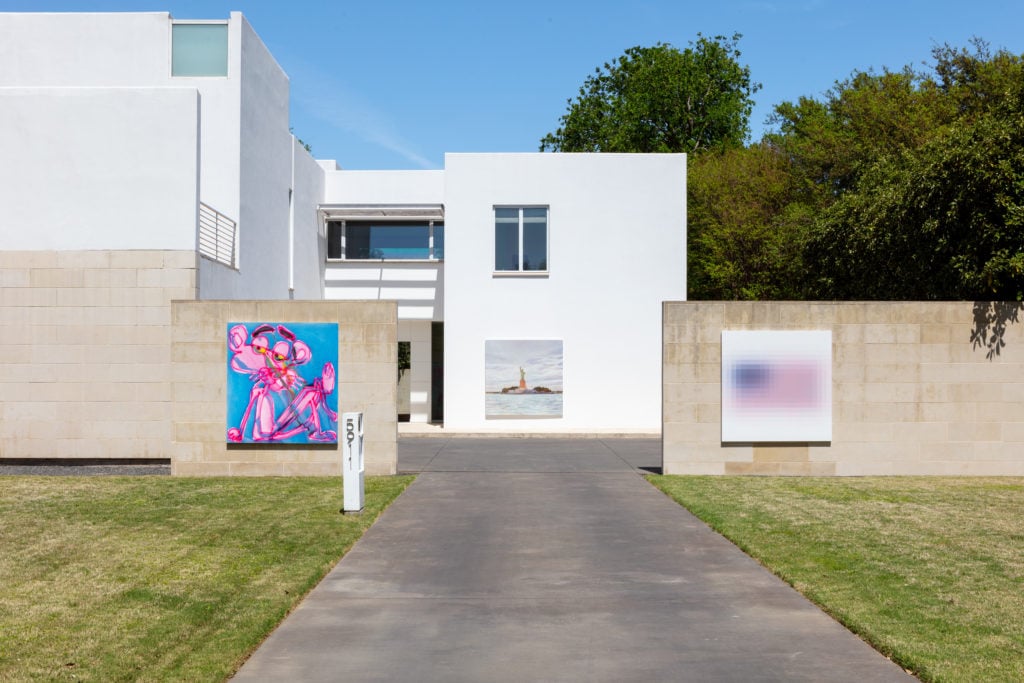
Installation view of “OUTDOOR PAINTING,” presented by Marlborough and CANADA, at the home of collectors Joe and Kristen Cole. Photography by Todora Photography. Courtesy of the Dallas Art Fair.
Longtime veterans of the fair agree that its energy was more Lower East Side than Park Avenue. Although megawatt Dallas collectors such as Howard Rachofsky and Marguerite Hoffman remain active at the fair, they still make up a relatively small group and do the bulk of their buying elsewhere. (This reporter has seen Rachofsky at more art fairs in the past year than the Ruinart champagne cart.)
And while it would be naive to assume that only residents of the Dallas-Fort Worth area attend the Dallas Art Fair—veterans talked about meeting clients traveling from Arkansas, Oklahoma, and elsewhere—Dallas itself skews young.
According to Brook Partners, the real-estate developers behind the River Bend complex that houses 214 Projects, the median age of residents in Dallas’s Design District is just 32.7 years, with an average annual household income over $100,000. That combination of youth, expendable cash, and cultural interest makes Dallas an oasis for precisely the type of fresh-faced middle-market collectors evaporating from traditional art capitals (and polarizing the trade in the process).
These factors occasionally coalesced into moments that could reinforce feelings that Dallas may yet be too much of an anything-goes frontier town for traditionalists. While perusing a booth on the higher-end first floor, I overheard one vexed dealer ask another’s advice about a client offering to buy a work, but only for a 20 percent discount and a split of the sales tax. Their compatriot laughed and said it was the most brazen offer they’d heard outside Mexico City, where they claimed they were once offered $9,000 in cash in a duffel bag for a work that cost multiples of that amount.
So has Dallas’s growth propelled it beyond its usual designation as a regional market—industry code for one that may not yet be worth a sustained and serious effort for the biggest sellers?
A better question is this: Shouldn’t we be more concerned with what it could do for the tier beneath the apex?
Either way, what’s certain is that dealers hung up on instant, runaway success will miss opportunities in a thriving, sustainable economy whose surface quirks belie exactly the kind of clientele so many claim they’re desperate to find. As the city and region around the Dallas Art Fair have proven in the past decade, just because you’re not paying attention doesn’t mean something valuable isn’t happening.